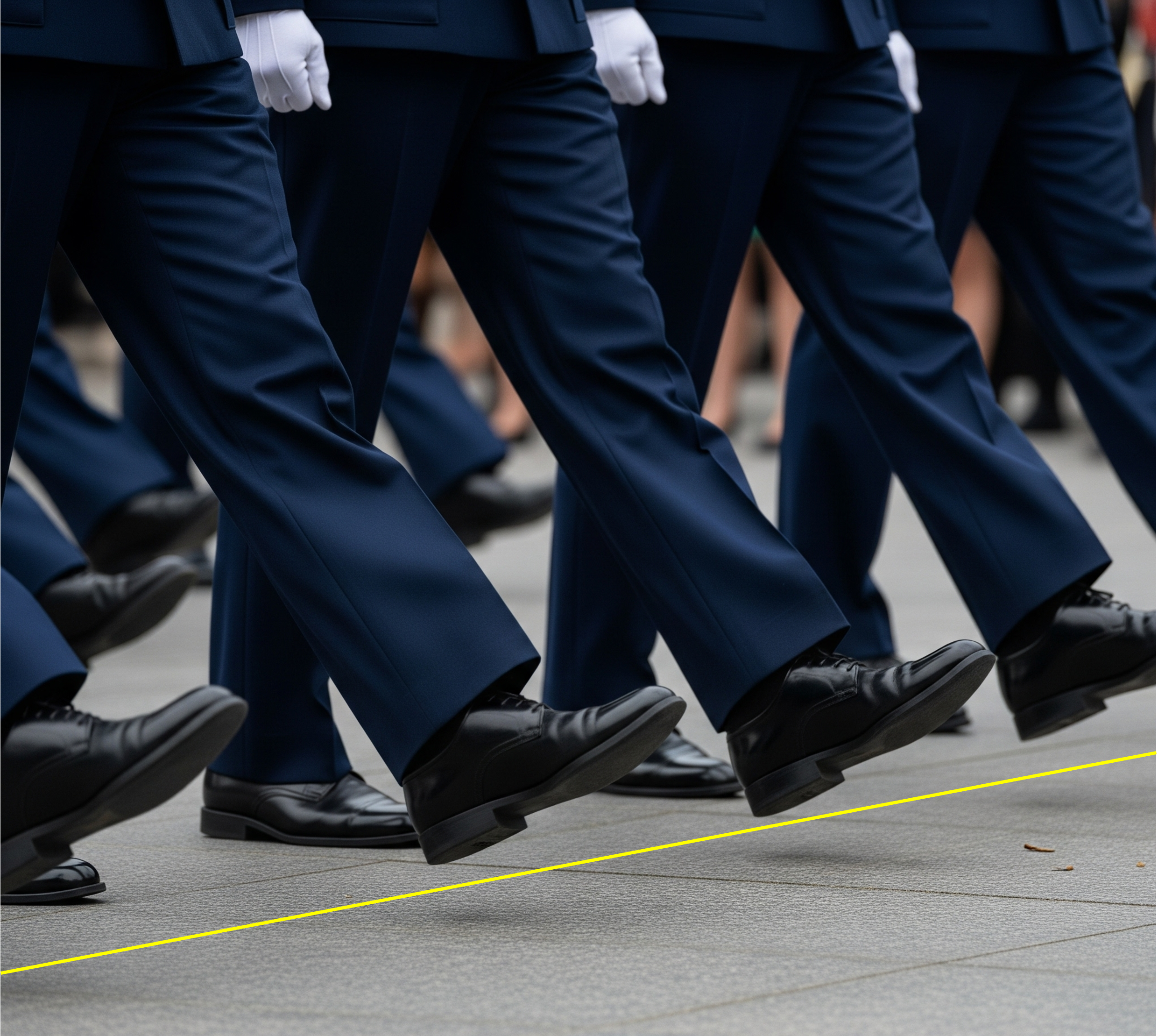I want to take this opportunity to talk about Movement Phasing
Phasing for our needs means movement that does not happen at the same time. Probably the easiest way to describe phasing is to talk about heel strikes while marching. See how all three heels will strike the marching surface at three different times? That’s phasing.
You are either:
- in step and in phase (all in the formation have their left and right heels strike at the same time),
- in step and out of phase (all in the formation have their left and/or right heels strike at almost the same time but you can see or hear the different strikes, shown in the AI image at the top of the page), or
- Everything Is Wrong, Start Over – to get in step and in phase (What movement scientists call a “gaggle”).
In Step, In Phase
Keep doing what you are doing but remember this: when the members of the formation learn something new, phasing will creep back in and as the new movement is digested and normalized*, phasing will disappear. This is a natural phenomenon.
*Multiple Responsibilities: “Digesting and Normalizing” new movement means the team members learn something new and eventually make the movement look as though the team has been marching that for weeks.
We stand at Attention and have all of the responsibilities associated with the position. We then step off to march forward, we 1) remain at Attention except for arm swing and leg movement, 2) align to the front, 3) align to the right, 4) stay in step, 5) stay in phase, 6) use proper technique to not bounce, 7) march in a straight line, and more. That’s over seven responsibilities each individual team member must learn and simultaneously execute with every step.
Now add in pivots and the multiple requirements for those, marching in place, (To the) Rear March, etc. and then add in rifle movement. Every time a new movement is introduced, other things seem to fall apart but concentration will return to encompass all of the old responsibilities and the new one(s) just introduced.
In Step, Out of Phase
I recommend using the Loud Metronome app. I show you how to set it up in this article, A Metronome Can Help! You want all heels to strike the marching surface at as close to the exact same time.
- Call Commands: You must call commands in tempo, and the metronome will really force you to pay attention to each syllable. Learn more in the article, A DrillMaster Study on the Command Voice, https://thedrillmaster.org/2017/10/10/a-drillmaster-study-on-the-command-voice/
- Marching: Set the to 4/4 or 2/4, in the middle of your service tempo range: Army – 120; MC/N/CG – 116; and AF/SF – 110. Colors postings are good at 85/90 steps per minute. If you use 2/4, you can easily set a high tone on the first beat and you can use that as the left heel strike. Using the same tone for both heel strikes is just fine too.
- The tempo ranges were created for movement of troops at a speed slow enough to not excessively tire everyone in formation and fast enough to move the formation efficiently.
- Rifle Movement: 100 is a good tempo to use. A faster tempo looks rushed and cause a lack of articulation (counts run into each other, no separation).
Everything Is Wrong, Start Over
Stop and start over from the beginning. Reviewing from the beginning, Attention, facing movements, Parade Rest, taking the first step, and marching can do a world of good, not matter how advanced your team might be.
Phasing Beyond Heel Strikes
It’s not just about aesthetics, although a drill team performance with movement phasing is just not going to be as pleasing to watch as a more precise performance. Being in phase contributes to unit cohesion, creates a powerful visual and auditory impact, and facilitates precise movements.
Being in or out of phase relates to unit discipline and uniformity. Imagine just “putting up with” being out of step or phase and having a general lack of precision. If we cannot handle simple tasks, how are we supposed to be trusted with more complex tasks? Overcome phasing and improve coordination, build discipline, and enhance teamwork? The sum is greater than the parts here.
As noted at the beginning, heel strikes are just a starting point. Other aspects of phasing are arm swing, and movement for the hand salute, head turns (Eyes Right), and manipulation of equipment, the rifle, sword, or flagstaff.
Keep pushing to improve. All the best to you and your team!

